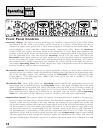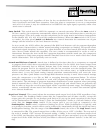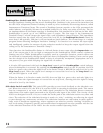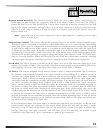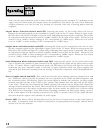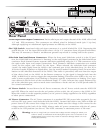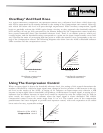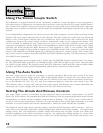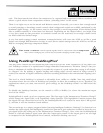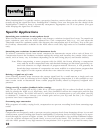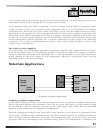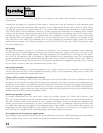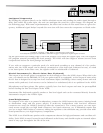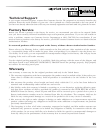
Two channels of program material do not necessarily constitute a stereo program. A stereo program is
one where the two channels are recorded and/or mixed to create the illusion of a single unified panora-
ma of sound. The stability of the psychoacoustic image of each sound source within the stereo spectrum
depends upon its ability to maintain a specific phase and amplitude relationship from the left to the right
channel.
If two independent compressors are used to process the stereo program, a loud sound occurring in one
channel will cause a gain reduction only in that channel. This gain reduction would cause the perceived
image of any sound spread between the two channels to move toward the side which had not been
compressed, because the spread signal would be momentarily softer in the compressed channel. This
can be avoided by linking the two compressors in such a way that both channels receive the same
amount of compression. On the 162SL, this is accomplished by means of the Stereo Couple switch. When
activated, the 162SL permits the RMS detectors of both channels to “talk” to one another. The SLAVE
channel (right, channel 2) then sends its signal to the MASTER channel (left, channel 1), where the RMS
power of the MASTER and SLAVE signals are combined to generate a control voltage. This control volt-
age is then used to compress both the MASTER and SLAVE channels equally. This dbx process is called
True RMS Power Summing™
When compressing a stereo program with a 162SL, only the MASTER channel controls need to be adjust-
ed. The Threshold LEDs, Auto LED, and PeakStop (Plus) LED will not light on the “slave” channel when
the 162SL is stereo linked. The Bypass switch and LED, Sidechain switch and LED, and the Meter Mode
switches and LEDs remain channel-independent and function normally in linked mode.
The Auto switch sets the 162SL for automatic or manual operation. When the Auto switch is IN (Auto
mode), the LED indicator lights and the 162SL automatically adjusts its attack rate and release time to
suit the program envelope. (This Auto mode sets the 162SL for the same attack and release characteris-
tics as dbx Models 160, 161, 162, 163, and 164 compressor/limiters), when the auto switch is out. The
LED indicator above it turns OFF, and the front panel Attack and Release rate controls determine the
maximum rate of gain change and the behavior of the level detector circuitry.
The 162SL offers a choice of automatic or user-adjustable attack and release characteristics. In AUTO
mode, the 162SL utilizes the patented dbx RMS level detector with its program-dependent attack/release
characteristics to obtain natural sounding compression or limiting. The AUTO mode works well for
vocals as well as most instruments. However, for special effects and certain signal situations, it is often
desirable to set fixed attack and release characteristics. MANUAL mode affords this capability.
The MANUAL attack and release controls employ AutoVelocityTM Dynamics (AVD) circuitry. AVD cir-
cuitry allows for manually adjustable, program-dependent, attack and release timings. For signals that
change slowly, they will experience a shorter attack and release time (roughly a factor of 10 times less
than the markings on the attack and release controls). For signals that change quickly (i.e. snare drum
hit) the attack and release times speed up to reflect the actual markings of the attack and release con-
Setting The Attack And Release Controls
Using The Auto Switch
Using The Stereo Couple Switch
18



